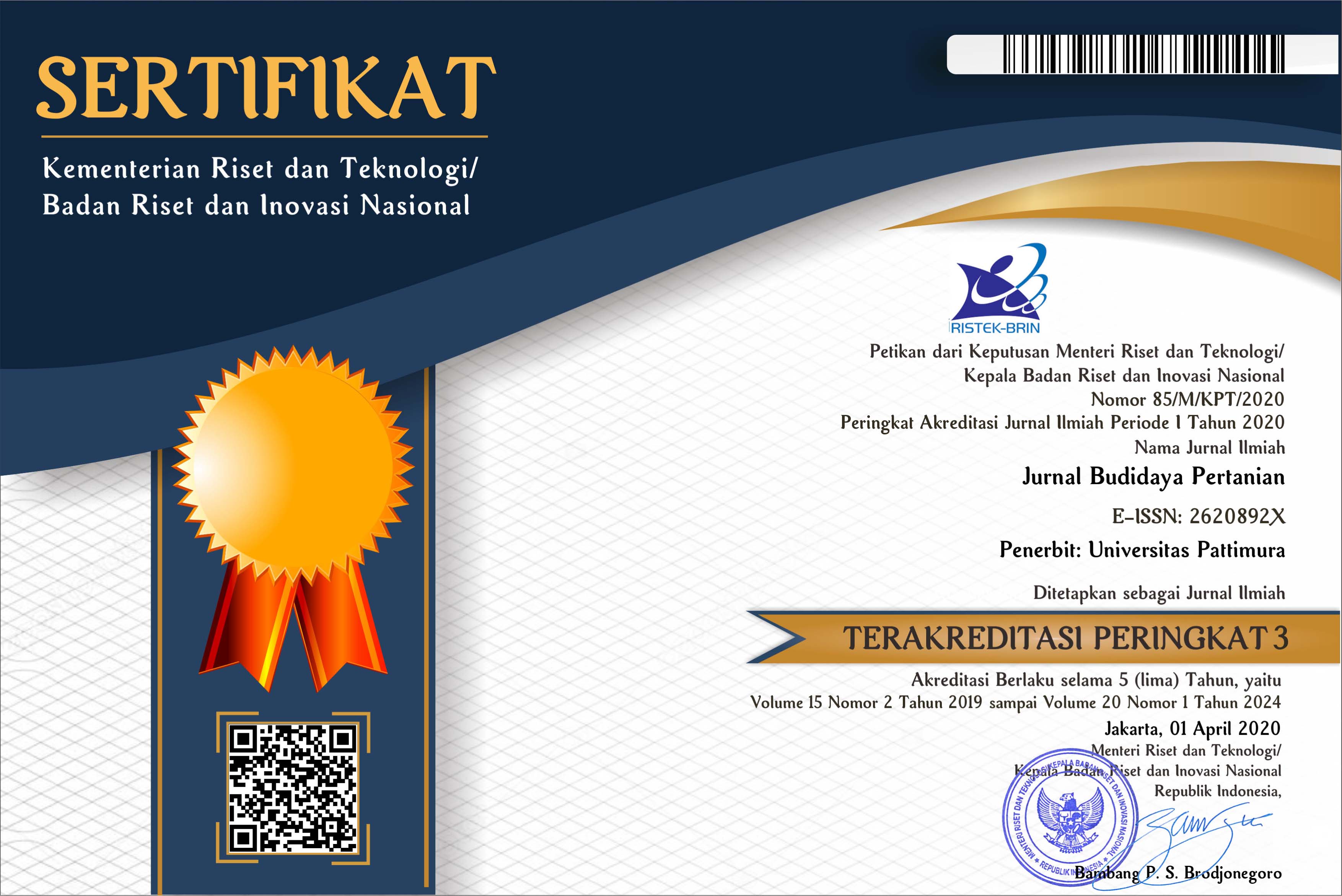Analysis of the level of Vegetation Density in the City of Ambon Based on NDVI Using Landsat 8 OLI Imagery
Abstract
Vegetation can be interpreted as a combination of several plants with different types living together in a place that forms a unit that interacts with each other, both among individuals from the plants themselves and the interaction of environmental factors. Vegetation density is the percentage of a group of plants or vegetation that live in an area. Vegetation index transformation (NDVI) is one of the data processing techniques to determine vegetation density. This study aims to determine the level of vegetation density in Ambon City using the NDVI Landsat 8 OLI imagery transformation. The method used in this research was the Normalized Difference Vegetation Index (NDVI) transformation of Landsat 8 OLI imagery. Based on the results of the study, there were five levels of vegetation density, namely: non-vegetation with a value of -0.6320-0.3660, a very low-density level with a value of 0.3661-0.5562, a low-density level with a value of 0.5563-0.7464, medium density level with value of 0.7465-0.8732 and a high-density level with value of 0.8733-1.00000. The land covers found were built-up areas, shrubs, mixed plantations, mixed crops, and secondary dryland forests. The non-vegetation class has an area of 761.95 ha (2.37%), the very low-density level has an area of 1234 ha (3.83%), the low-density level has an area of 2333.87 ha (7.25%), the medium density level has an area 3689.10 (11.45%), and the high-density level has an area 24194.29 ha (75.10%). The accuracy of the analysis of the research was a very good category because the Kappa value was 91% and overall accuracy was 93%.
Downloads
References
As-Syakur, Rahman, A., & Adnyana, I. W. S. (2009). Analisis indeks vegetasi menggunakan citra ALOS/AVNIR-2 dan sistem informasi geografi (sig) untuk evaluasi tata ruang Kota Denpasar. Jurnal Bumi Lestari, 9(1), 1-11. https://ojs.unud.ac.id/index.php/blje/article/view/611
BPS Kota Ambon. (2021). Kota Ambon dalam angka. Ambon: BPS Kota Ambon.
Danoedero, P. (2012). Pengantar Penginderaan Jauh Digital. Yogyakarta: ANDI.
Djurdjani & Kartini. (2004). Pengolahan citra digital. Teknik Geodesi Universitas Gadjah Mada. Yogyakarta.
Hardianto, A., Dewi, P. U., Feriansyah, T., Sari, N. F. S., & Rifiana, N. S. (2021). Pemanfaatan Citra Landsat 8 dalam mengidentifikasi nilai indeks kerapatan vegetasi (NDVI) Tahun 2013 dan 2019 (Area Studi: Kota Bandar Lampung). Jurnal Geosains dan Remote Sensing, 2(1), 8-15. https://doi.org/10.23960/jgrs.2021.v2i1.38
Horning, N. (2004). Global land vegetation. An Electronic Textbook. NASA Goddard Space Flight Center Earth Sciences Directorate Scientific and Educational Endeavors (SEE). http://www.cepo.odu.edu/SEES/veget/vg_ class.html.
Jaya, I. N. S. (2014). Analisis citra digital: Perspektif penginderaan jauh untuk pengelolaan sumber daya alam. Bogor: IPB Press. ISBN: 978-979-493-702-0.
Ji, L., & Peters, A. J. (2007). Performance evaluation of spectral vegetation indices using a statistical sensitivity function. Remote Sensing of Environmental, 106, 59-65. https://digitalcommons.unl.edu›
Lillesand, T., Kiefer, R. W., & Chipman, J. (2004). Remote sensing and image interpretation. (The 5th edition). Jhon Wiley & Sons, Inc. New York.
Siahaya, W. A. (2016). Pengaruh perubahan tutupan lahan terhadap perubahan penutup bentik dasar perairan pesisir pulau kecil berdasarkan citra satelit resolusi menengah (Studi kasus empat belas DAS yang bermuara di Teluk Ambon). Disertasi S3, Program Pascasarjana, Universitas Gadjah Mada, Yokyakarta.
Tucker, C. J., Townshend, J. R. G., & Goff, T. E. (1985). African land-cover classification using satellite data. Science, 227, 369–375.
Turner, B. L., Lambin, II., & Reenberg, E. F. (2007). The emergence of land change science for global environmental change and sustainability. Proc. Natl. Acad. Sci., 104(52), 20666–20671. https://www.pnas.org/doi/10.1073/pnas.0704119104
Van Niel, T. G. & McVicar, T. R. (2001). Remote sensing of rice-based irrigated agriculture: A review. Cooperative Research Centre for Sustainable Rice Production, P1105-01/01, Yanco, NSW, Australia,
Wu, C. D., Chen, Y. C., Pan, W. C., Zeng, Y. T., Chen, M. J., Guo, Y. L., & Lung, S. C. C. (2017). Land-use regression with long-term satellite-based greenness index and culturespecific sources to model PM2. 5 spatialtemporal variability. Environmental Pollution, 224, 148-157. https://doi.org/10.1016/j.envpol. 2017.01.074.
Yanti, D., Megantara, I., Akbar, M., Meiwanda, S., Syauqi, M., Sugandi, I., D., & Ridwana, R. (2020). Analisis kerapatan vegetasi di Kecamatan Pangandaran melalui citra Landsat 8. Jurnal Geografi, Edukasi dan Lingkungan, 4(1), 32-38. https://doi.org/10.29405/jgel.v4i1.4229.
Yin, H., Udelhoven, T., Fensholt, R., Pflucmacher, D., & Hostert, P. (2012). How normalized diffrence vegetation indeks (NDVI) from advanced very high resolution radiometer (AVHRR) adn system probatoire d’observation de la terre vegetation (SPOT VGT) time series differ in agricultural areas: An inner Mongolian case study. Journal Remote Sensing, 4, 3364-3389. https://doi.org/10.3390/rs4113364
Yunhao, C., Peijun, S., Xiaobing, L., C., Jin, and Jing, L. (2006). A combined approach for estimating vegetation cover ini urban/suburban environments from remoteely sensed data. Computers & Geosciences, 32, 1299-1309. https://doi.org/10.1016/j.cageo.2005.11.011
Copyright (c) 2023 Lisa C Silooy, Willem A Siahaya, Johanes P Haumahu

This work is licensed under a Creative Commons Attribution-ShareAlike 4.0 International License.

 Accreditation is valid for 5 years, starting from Volume 15 Issues 2 December 2019 up to Volume 20 Issue 1 June 2024.
Accreditation is valid for 5 years, starting from Volume 15 Issues 2 December 2019 up to Volume 20 Issue 1 June 2024.






